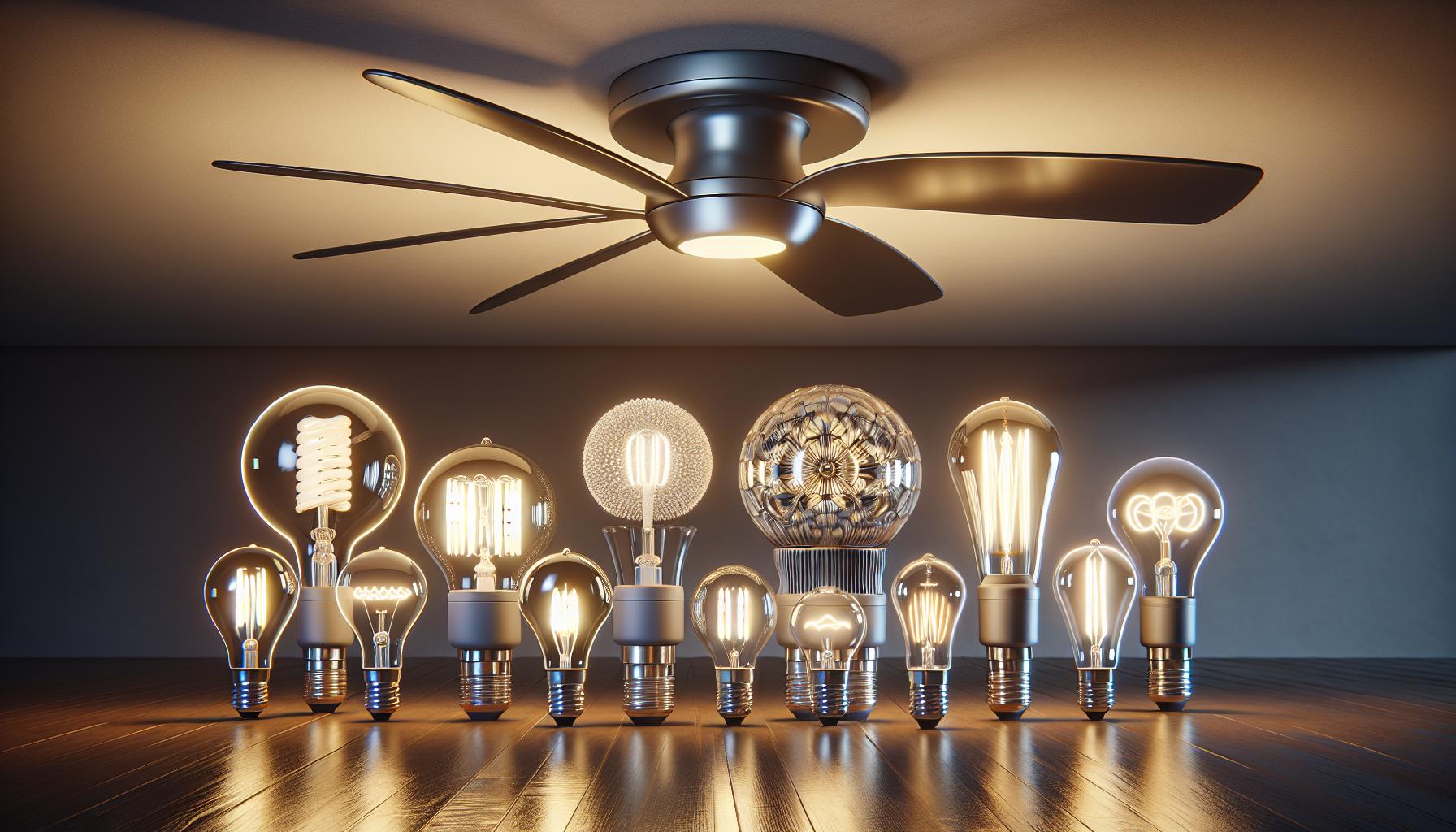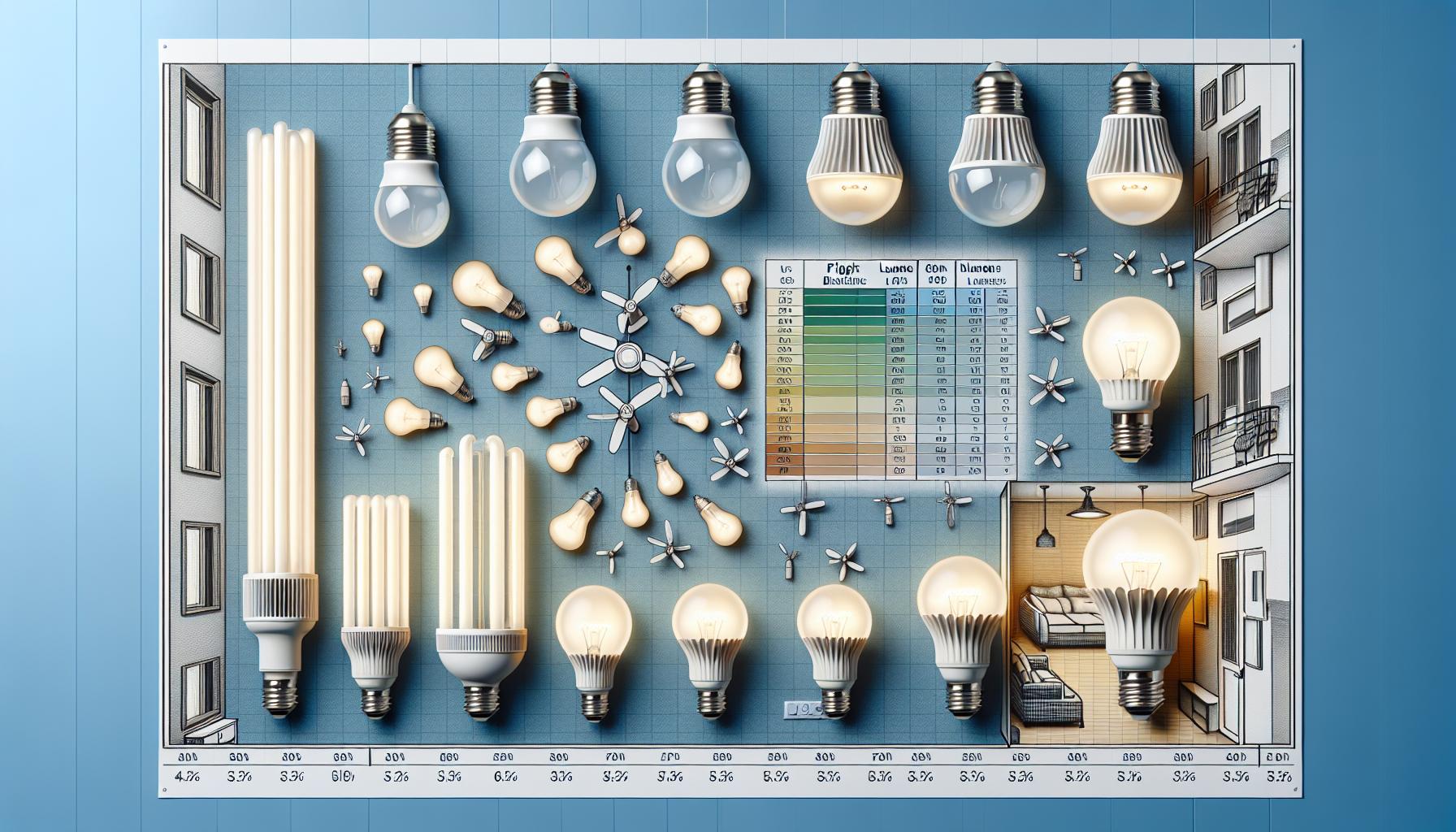Ever found yourself squinting under the light of your ceiling fan, wondering if you could brighten things up? You’re not alone. Choosing the right size light bulb for your ceiling fan is key to enhancing your room’s ambiance and functionality.
Navigating the world of wattage, bulb shapes, and sizes might seem daunting, but don’t worry! You’re about to discover how simple it can be to find the perfect light bulb that not only fits your fan but also shines just the right amount of light for your space.
Why the right size light bulb matters for ceiling fans
When you’re on the hunt for the perfect light bulb for your ceiling fan, you might wonder if size really matters. It does, and here’s why. Ceiling fans are designed to be functional, energy-efficient, and an aesthetic complement to your room. The wrong size bulb can throw off more than just your room’s ambiance.
Ceiling Clearance is a prime factor. A bulb that’s too large may not fit into the fan’s light fixture or could extend beyond the glass casing, which isn’t safe. But a bulb that’s too small could fail to make the most of the fan’s design, leaving you with a lackluster light output.
Optimized Illumination
The right bulb size ensures you get:
- Proper Light Spread: A bulb that’s too small won’t provide enough illumination for your room, while one that’s oversized could create glare.
- Energy Efficiency: Choosing the correct bulb ensures you’re not over-lighting, which saves energy and keeps your electricity bills in check.
- Aesthetic Balance: Your room decor matters, and the bulb should complement both the fan and the room’s design without looking out of place.
Heat Management
Light bulbs generate heat, and the size impacts how this heat is dissipated. Fans are intended to help regulate room temperature, and the wrong bulb size can counteract this by generating unnecessary heat.
Lifespan and Maintenance
Correctly sized bulbs have a longer lifespan as they fit well within the fan’s design specifications, minimizing the frequency of replacement. Moreover, when the bulb size is right, maintenance is a breeze since everything fits and functions as intended.
Approaching your lighting from a strategic angle offers practical benefits while also satisfying your inner home DIY enthusiast. Remember that in lighting, as in life, the right fit makes all the difference. Keep these considerations in mind and you’ll not only enjoy better lighting but also a more comfortable, inviting space.
Understanding wattage and its impact on lighting
When you’re digging into the details of light bulbs for your ceiling fan, it’s crucial to understand that wattage isn’t just a number on a package; it’s a direct indicator of power consumption and light output. Light bulb wattage essentially measures how much energy the bulb uses to produce light. Traditionally, higher wattage meant brighter light, but with the advent of energy-efficient bulbs like LEDs, this relationship isn’t as straightforward.
Let’s break it down:
- Incandescent bulbs: The higher the wattage, the brighter the light.
- LEDs and CFLs: Low wattage can still deliver high lumens—the actual measure of brightness.
How Wattage Affects Energy Efficiency
In your quest for the perfect light bulb, if saving on your electricity bill is a priority, you’re likely interested in highly efficient bulbs. LEDs and CFLs are your go-to options here, with an emphasis on LEDs for their longevity and lower energy usage—even at lower wattages, they often provide the same level of brightness as higher-wattage incandescents.
Here’s a quick comparison in terms of energy usage:
| Bulb Type | Incandescent | LED | CFL |
|---|---|---|---|
| Wattage (W) | 60 | 10 | 14 |
| Lumens (lm) | ~800 | ~800 | ~800 |
Remember, lower wattage equals lower energy consumption, so when you pick a bulb for your ceiling fan, consider how swapping to a lower wattage LED or CFL could create savings on your energy bill.
The Link Between Wattage and Heat Output
« Can Light Bulbs Be Painted? How To Safely Add Color to Your Lights
Are Fridge Light Bulbs Different? Uncovering the Chilling Truth »
One aspect that’s often overlooked is the heat that’s generated by bulbs with higher wattage. This isn’t just about the touch test—it’s about the impact on your fan’s lifespan and your overall comfort. High wattage bulbs can produce more heat, potentially shortening the life of your ceiling fan’s motor. With that in mind, you might want to opt for cooler-running bulbs.
Different bulb shapes and their suitability for ceiling fans
Choosing the ideal light bulb for your ceiling fan involves more than just considering wattage; bulb shape plays a crucial role in both aesthetics and functionality. Ceiling fans typically accommodate a variety of bulb shapes, which means you’ve got options, but not all shapes are equal in their suitability.
Standard Bulb Shapes Include:
- A-shape: The classic bulb shape, often designated as A19, provides widespread illumination and is a staple for general lighting needs.
- Candle or C-shape: These slim bulbs mimic the look of a candle flame and are perfect for ceiling fans with chandelier or sconce-type light kits.
- Globe or G-shape: With a rounder, fuller appearance, globe bulbs offer a modern look and an even ambient light that’s ideal for fans in large, open spaces.
- Reflectors or R-shape: These bulbs have a reflective coating to direct the light downwards, which is advantageous if you’re looking to spotlight a particular area of the room.
When you’re scouring the aisles or browsing online for that perfect bulb, consider both the overall design of your ceiling fan and the type of lighting effect you’re after. For instance, if your fan is installed in a cozy reading nook, you might want globe bulbs that provide softer, more diffuse lighting. On the other hand, for your activity-driven kitchen, reflector bulbs might be the ticket to focused task lighting.
Bulb shape also determines how light is distributed across a room. A-shape bulbs may throw light in all directions, which can be great if you’re looking to light up a large, open-plan living space. If you prefer more localized lighting, like over a dining table or kitchen island, R-shape bulbs are your go-to as they focus the light downward.
Remember, regardless of shape, you’ll want to stick with cooler-running bulbs like LEDs or CFLs to keep that heat generation in check. The right bulb shape paired with energy efficiency won’t just brighten up your room; it’ll also maintain the integrity of your ceiling fan for years to come. Keep in mind, it’s all about balance. Balancing aesthetics with functionality ensures you’ll enjoy both the light and the breeze of your ceiling fan to the fullest.
How to determine the appropriate size light bulb for your ceiling fan
Navigating the world of light bulbs can be tricky, but with a bit of guidance, you can find the perfect match for your ceiling fan. Let’s kick things off by talking about the two key factors you should consider: bulb base size and bulb shape.
Most ceiling fans are designed with a standard base size, known as an E26 in the US. This means that any medium-sized bulb—whether it’s an LED, CFL, or incandescent—should fit seamlessly into your ceiling fan’s light fixture. However, it’s always best to double-check your fan’s specifications before making a purchase.
Once you’ve confirmed the base size, it’s time to look at bulb shapes. Ceiling fan fixtures often accommodate A-type bulbs, which are arguably the most common and versatile bulb shape and will likely align well with your fan’s design. But you might also encounter fixtures that can fit globe bulbs (G-type) or even candles (C-type), especially if your fan has a more decorative or vintage design.
While sifting through various bulb shapes, pay close attention to the dimensions of the bulb. Grab a tape measure and jot down the measurements of any existing bulbs or the light fixture itself. You’ll want to ensure that your new bulb won’t protrude awkwardly from the fan.
Here are some tips to keep you on the right track:
- Verify the base size: Check the manual or look up the fan model online.
- Measure for fit: Ensure the bulb will sit comfortably in the fixture.
- Assess your room size: Wider or larger bulbs may be more appropriate for spacious rooms.
Moreover, the glass surrounding the bulb inside the fan’s light kit, known as the globe or shade, can also impact your choice. A clear globe will showcase the bulb’s design, so you might opt for a more decorative bulb, while a frosted globe diffuses light and may allow for a wider selection of shapes and sizes without impacting the room’s aesthetics.
In essence, matching the right bulb to your ceiling fan is a balance of practicality and personal style. Keep in mind that you’re not just looking for any bulb that fits—you’re aiming to enhance both the functionality and the ambiance of your space.
Factors to consider when choosing the brightness level of your light bulb
When selecting the right brightness level for your ceiling fan light bulb, it’s not just about wattage. Lumens measure light output, providing a more accurate indication of brightness. With lighting, you’re aiming for the sweet spot that illuminates your room without being harsh or underwhelming.
Understand Lumens vs. Wattage
Ever since the switch to energy-efficient bulbs, understanding brightness requires a bit of re-education. Traditional incandescent bulbs used wattage to indicate brightness, but with LEDs and CFLs, the rule has changed. For example:
| Bulb Type | Wattage | Equivalent Brightness (Lumens) |
|---|---|---|
| LED | 10 W | ~800 lm |
| CFL | 14 W | ~800 lm |
| Incandescent | 60 W | ~800 lm |
This means you can have a brighter room with less energy consumption.
Room Size and Purpose
You’ll need to tailor the brightness based on room size and purpose:
- Smaller rooms may need fewer lumens.
- For larger spaces, consider higher lumens to maintain ample visibility.
Think about the room’s function. A bedroom may require soft, warmer light compared to a home office that benefits from bright, cool light to keep you alert.
Consider Dimmable Options
If versatility in brightness is important to you, dimmer switches are a game changer. They allow you to:
- Adjust light levels to suit the time of day
- Change the mood for different occasions
- Save energy by using less light when full brightness isn’t necessary
Keep in mind, not all light bulbs are dimmable, and you’ll need a compatible fan unit, so check your product specifications.
Check Compatibility With Your Fan
Finally, double check that the bulb’s brightness is suitable for your ceiling fan’s limitations. Too high lumens could impact the fan’s functionality or even damage the fixture. Always refer to your ceiling fan’s manual as the ultimate guide.
Finding the perfect balance may seem like a bit of a puzzle, but once you factor in lumens and room elements, you’re well on your way to achieving ideal lighting. Remember, the right brightness enhances not just visibility but also the overall ambiance of your home.
Conclusion
Choosing the right light bulb for your ceiling fan ensures you get the perfect balance of brightness, energy efficiency, and longevity for your fixture. Remember to consider lumens for brightness, not just wattage, and keep in mind the size of your room when making your selection. Opting for cooler, energy-efficient bulbs like LEDs or CFLs can also help preserve your ceiling fan’s motor. With the right bulb, you’ll enjoy a well-lit and comfortable space for years to come. Happy lighting!
Frequently Asked Questions
What is the main factor to consider when choosing a light bulb for a ceiling fan?
The main factor is the bulb’s size to ensure it fits the ceiling fan. Additionally, consider the bulb’s wattage for power consumption, light output, and the potential heat it may generate, which can affect the fan’s lifespan.
Is higher wattage necessary for a brighter light in energy-efficient bulbs?
No, for energy-efficient bulbs like LEDs and CFLs, higher wattage isn’t necessary for more brightness. They have a better lumens-to-wattage ratio, meaning they can provide the same brightness for less wattage.
How does wattage affect the heat output of a bulb?
Higher wattage bulbs can generate more heat. This excess heat can shorten the lifespan of the ceiling fan’s motor, so opting for lower-wattage, cooler-running bulbs is recommended.
What should be considered when deciding on the brightness level for a ceiling fan light bulb?
When choosing the brightness, consider lumens as an indicator of brightness, the size and purpose of the room, and whether you want dimmable lighting. Balance these factors with the bulb’s compatibility with the fan.
Is it important to check light bulb compatibility with my ceiling fan?
Yes, it’s very important to confirm compatibility to prevent safety issues, ensure optimal lighting, and avoid potential damage to the ceiling fan that may arise from using an unsuitable bulb.





